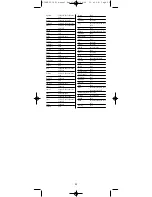
15
TROUBLESHOOTING
PROBLEM:
LED
(red light) does not blink when you press a key.
SOLUTION:
Replace batteries with two new AAA alkaline batteries.
PROBLEM:
LED
blinks when you press a key, but home entertain-
ment device does not respond.
SOLUTION:
Make sure the remote control is aimed at your home
entertainment device and is not farther than 15 feet
away.
PROBLEM:
The unit does not control home entertainment devices
or commands are not working properly.
SOLUTION:
Try all listed codes for the device brands being set up.
Make sure they can be operated with an infrared remote
control.
PROBLEM:
Changing channels does not work.
SOLUTION:
If original remote required pressing ENTER or SELECT to
change channels,press
ENTER
or
SELECT
on this remote after
entering the channel number.
PROBLEM:
Tried
Searching For Your Code
method and still could not
find a working code.
SOLUTION:
Clear the device key as follows: Press and hold
SET
until
the
LED
(red light) blinks twice, then release. Next enter
9
-
9
-
2
. Then press the device key to be cleared twice.
Now repeat the
Searching For Your Code
method on page
9.
PROBLEM:
CH
▲
and
CH
▼
do not work for your RCA TV.
SOLUTION:
Due to RCA design (1983-1987), only the original
remote control will operate these functions.
PROBLEM:
No remote control of volume.
SOLUTION:
See
Changing Volume Lock
on page 12 to lock/unlock
volume.
For assistance, please contact us in any of the following ways:
•
E-mail: [email protected]
•
Internet: http://www.oneforall.com
•
Consumer Help Line: (330) 405-8612
INSTRUCTIONS TO THE USER
This equipment has been tested and found to comply with the limits for a class B
digital device, pursuant to part 15 of the FCC Rules. These limits are designed to
provide a reasonable protection against harmful interference in a residential
installation. This equipment generates, uses, and can radiate radio frequency
energy and if not installed and used in accordance with the instructions, may
cause harmful interference to radio communications. However, there is no guar-
antee that interference will not occur in a particular installation. If this equip-
ment does cause harmful interference to radio or television reception, which can
be determined by turning the equipment off and on, the user is encouraged to
try to correct the interference by one or more of the following measures:
• Reorient or relocate the receiving antenna.
• Increase separation between equipment and receiver.
• Connect equipment into an outlet or a circuit different from that to which the
receiver is connected.
• Consult dealer or experienced radio/TV technician for help.
CTGAE3P 3021 manual booklet 5/24/04 12:46 PM Page 15



























